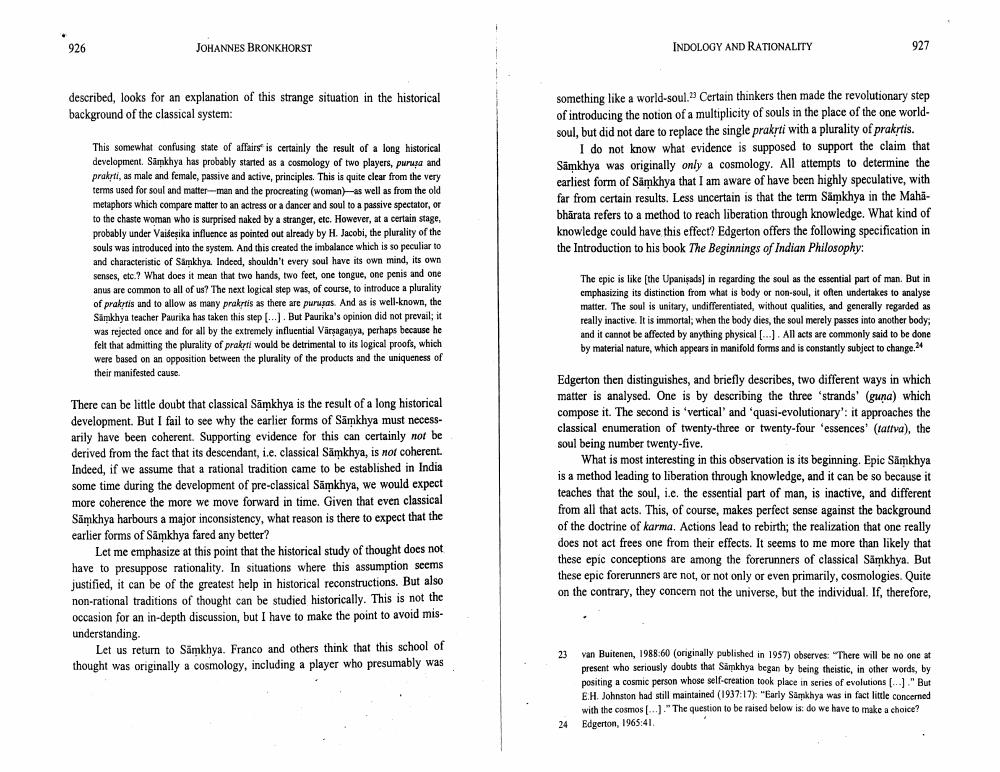Book Title: Indology And Rationality Author(s): Johannes Bronkhorst Publisher: Johannes Bronkhorst View full book textPage 6
________________ 926 JOHANNES BRONKHORST INDOLOGY AND RATIONALITY 927 described, looks for an explanation of this strange situation in the historical background of the classical system: This somewhat confusing state of affairs is certainly the result of a long historical development. Simkhya has probably started as a cosmology of two players, pure and prakyti, as male and female, passive and active, principles. This is quite clear from the very terms used for soul and matter man and the procreating (woman) as well as from the old metaphors which compare matter to an actress or a dancer and soul to a passive spectator, or to the chaste woman who is surprised naked by a stranger, etc. However, at a certain stage. probably under Vaidesika influence a pointed out already by H. Jacobi, the plurality of the souls was introduced into the system. And this created the imbalance which is so peculiar to and characteristic of Samkhya. Indeed, shouldn't every soul have its own mind, its own senses, etc.? What does it mean that two hands, two fect, one tongue, one penis and one anus are common to all of us? The next logical step was, of course, to introduce a plurality of praktis and to allow as many praktis as there are purusesAnd as is well-known, the Samkhya teacher Paurika has taken this step [...) But Puurika's opinion did not prevail;it was rejected once and for all by the extremely influential Varsaganya, perhaps because he felt that admitting the plurality of prakrti would be detrimental to its logical proofs, which were based on an opposition between the plurality of the products and the uniqueness of their manifested cause something like a world-soul. Certain thinkers then made the revolutionary step of introducing the notion of a multiplicity of souls in the place of the one worldsoul, but did not dare to replace the single prakrti with a plurality of praktis. I do not know what evidence is supposed to support the claim that Samkhya was originally only a cosmology. All attempts to determine the earliest form of Samkhya that I am aware of have been highly speculative, with far from certain results. Less uncertain is that the term Simkhya in the Mahibhärata refers to a method to reach liberation through knowledge. What kind of knowledge could have this effect? Edgerton offers the following specification in the Introduction to his book The Beginnings of Indian Philosophy: The epic is like (the Upanisads) in regarding the soul as the essential part of man. But in emphasizing its distinction from what is body or non-soul, it often undertakes to analyse matter. The soul is unitary, undifferentiated, without qualities, and generally regarded as really inactive. It is immortal, when the body dies, the soul merely passes into another body, and it cannot be affected by anything physical [...]. All acts are commonly said to be done by material nature, which appears in manifold forms and is constantly subject to change. There can be little doubt that classical Samkhya is the result of a long historical development. But I fail to see why the earlier forms of Samkhya must necessarily have been coherent. Supporting evidence for this can certainly not be derived from the fact that its descendant, i.e. classical Samkhya, is nof coherent. Indeed, if we assume that a rational tradition came to be established in India some time during the development of pre-classical Samkhya, we would expect more coherence the more we move forward in time. Given that even classical Samkhya harbours a major inconsistency, what reason is there to expect that the earlier forms of Samkhya fared any better? Let me emphasize at this point that the historical study of thought does not have to presuppose rationality. In situations where this assumption seems justified, it can be of the greatest help in historical reconstructions. But also non-rational traditions of thought can be studied historically. This is not the occasion for an in-depth discussion, but I have to make the point to avoid misunderstanding. Let us return to Sämkhya, Franco and others think that this school of thought was originally a cosmology, including a player who presumably was Edgerton then distinguishes, and briefly describes, two different ways in which matter is analysed. One is by describing the three 'strands' (guna) which compose it. The second is 'vertical' and 'quasi-evolutionary': it approaches the classical enumeration of twenty-three or twenty-four 'essences' (tativa), the soul being number twenty-five. What is most interesting in this observation is its beginning. Epic Samkhya is a method leading to liberation through knowledge, and it can be so because it teaches that the soul, i.e. the essential part of man, is inactive, and different from all that acts. This, of course, makes perfect sense against the background of the doctrine of karma. Actions lead to rebirth; the realization that one really does not act frees one from their effects. It seems to me more than likely that these epic conceptions are among the forerunners of classical Samkhya. But these epic forerunners are not or not only or even primarily, cosmologies. Quite on the contrary, they concem not the universe, but the individual. If therefore, 23 van Buitenen, 1988.60 (originally published in 1957) observes: "There will be no one at present who seriously doubts that Samkhya began by being theistic, in other words, by positing a cosmic person whose self-creation took place in series of evolutions But E.H. Johnston had still maintained (1937:17): "Early Samkhya was in fact little concerned with the cosmos [...]." The question to be raised below is: do we have to make a choice? Edgerton, 1965:41. 24Page Navigation
1 ... 4 5 6 7 8 9 10 11 12 13
